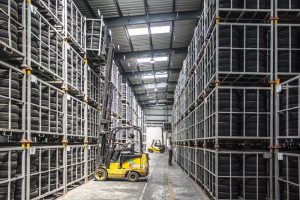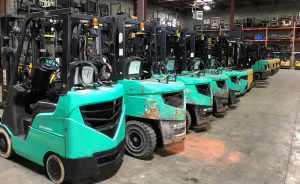Forklifts account for most injuries to warehouse employees, according to the Occupational Safety and Health Administration (OSHA). The OSHA states that at least 100 workers are killed in warehouses due to forklift accidents, and a further 95,000 are injured every year. Automation can reduce these risks by replacing forklifts in manufacturing.
The manufacturing industry has seen an increase in automated robot technology. According to a recent report by Interact Analysis, the worth of the mobile robot market will rise to $7 billion by 2022.
The technology giant Amazon is one of the larger multinational businesses to have invested heavily in robots. Amazon’s robotic roll-out started in 2012, and it has spent $775 million on Autonomous Mobile Robots (AMRs) to carry products across its facilities. The robots are equipped with sensors for navigation and to avoid risks of collision.
This has resulted in an uplift in productivity, and Amazon today continues to install robots in its warehouses. It currently has more than 200,000 AMRs working alongside human workers. Customers are demanding quicker turnarounds — especially if they’ve paid more money for faster delivery — and automation is a cheaper, safer and more-effective way for Amazon to fulfill these demands.
AMRs can certainly increase efficiency in warehouse environments. But, perhaps more importantly, there are the additional levels of safety that robots can bring for workers. The fact remains that, in the US, the rate of fatal injuries among warehouse workers is higher than the national average for all other industries.
Avoiding Risks
Risks may account for there being a higher shortage of skilled forklift drivers than ever before. Companies require workers to have more technical and analytical skills to operate the vehicle, but finding job-ready new recruits has proven to be an issue for manufacturers. This makes training essential.
However, the training is not straightforward and can prove expensive and time consuming; especially with the many health and safety regulations that companies must abide by. To be awarded their certification, candidates must undergo extensive training for skills like awareness and decision making, which are critical when maneuvering a forklift. Such recruitment procedures are costly for businesses, and many manufacturers are turning to automation as a result.
 AMR Options
AMR Options
There are many different kinds of AMR that companies can consider installing in manufacturing or warehousing facilities. For example, the Freight 500, assembled by Fetch Robotics, is an affordable option that has proven to be a massive hit in industry.
But how do humans work around them? The Freight 1500 has lidar sensors and a forward-looking red, green, blue, and depth (RGB-D) camera that enhances conventional images with depth information. There are also LED lights that prevent robots bumping into each other, and into human co-workers!
In addition, the machine comes in different sizes in order to be equipped to carry a variety of products that weigh anything from 500 kilograms (kg) to 1,500 kg. This helps boost productivity and save on inventory space.
Based on the success of AMRs like The Freight 1500, next year will see the first self-driving lift truck enter the market, the OTTO OMEGA. A game changer in the market, the self-driving truck is designed for all industry applications and to help reduce materials handling costs, increase output and improve safety in warehouses.
The human-like OTTO OMEGA autonomously picks up and drops off products, receives and puts away items, delivers parts, transports trash and works with workers to manage complex loading. What’s more, the self-driving truck can learn skills over time by capturing sensor data. This data can then be sent to an engineer, to program new and improved behavioral patterns for the robot.
American warehouse workers walk from between ten to 20 miles a day, picking and placing products according to Vox magazine’s Recode technology supplement. Despite the capability of AMRs to replace labor-consuming jobs, it’s clear that these machines still require much-needed human co-operation.
While the threat of automation to workers’ jobs remains an ongoing concern, few can argue with the role AMRs can play in reducing risks of injury. Regardless of the stage manufacturers are at in automating their warehouses, it’s crucial to consult an experienced obsolete parts supplier.
Editor’s Note: Jonathan Wilkins
is marketing director at
obsolete parts supplier
EU Automation
April 24, 2020






